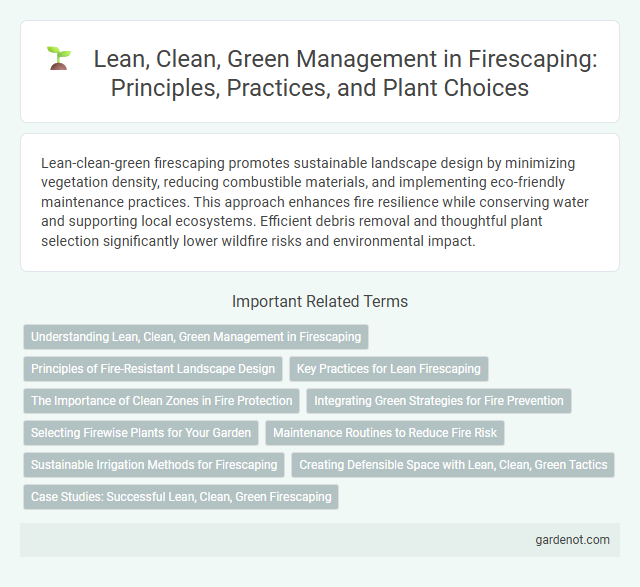Lean-clean-green firescaping promotes sustainable landscape design by minimizing vegetation density, reducing combustible materials, and implementing eco-friendly maintenance practices. This approach enhances fire resilience while conserving water and supporting local ecosystems. Efficient debris removal and thoughtful plant selection significantly lower wildfire risks and environmental impact.
Understanding Lean, Clean, Green Management in Firescaping
Lean-clean-green management in firescaping integrates efficient resource use, minimizing waste, and promoting ecological balance to reduce fire risk. Understanding this approach involves adopting sustainable landscaping practices that prioritize native, drought-resistant plants to create defensible spaces and enhance biodiversity. Emphasizing this management strategy supports fire resilience while conserving water and maintaining soil health.
Principles of Fire-Resistant Landscape Design
Lean-clean-green management emphasizes selecting fire-resistant plants that require minimal maintenance, reducing combustible materials near structures, and maintaining clear, healthy landscapes to prevent wildfire spread. Principles of fire-resistant landscape design include creating fuel breaks with strategic spacing, using low-resin vegetation, and ensuring proper irrigation to keep plants healthy and less flammable. Integrating these strategies results in safer, sustainable outdoor environments that help protect properties from wildfire risks.
Key Practices for Lean Firescaping
Lean-clean-green management in firescaping emphasizes minimizing fuel loads through targeted vegetation thinning, removing invasive species, and promoting native, fire-resistant plants. Key practices include strategic pruning to reduce ladder fuels, maintaining clear defensible spaces around structures, and implementing mulching or ground covers that suppress weed growth and retain soil moisture. These approaches enhance ecosystem health, reduce wildfire risks, and support sustainable land stewardship.
The Importance of Clean Zones in Fire Protection
Clean zones play a critical role in firescaping by reducing the risk of ignition and fire spread near structures. Maintaining lean-clean-green management involves regular removal of dead vegetation, debris, and other flammable materials within these designated buffer areas. This strategic clearance enhances fire protection by creating defensible space that slows fire progression and protects property from wildfire damage.
Integrating Green Strategies for Fire Prevention
Lean-clean-green management emphasizes integrating sustainable landscaping practices to reduce wildfire risks while enhancing ecosystem health. Utilizing drought-tolerant native plants, removing combustible debris, and implementing efficient irrigation systems create defensible spaces that minimize fire hazards. Strategic planning of vegetation zones and green infrastructure supports fire prevention while promoting biodiversity and resource conservation.
Selecting Firewise Plants for Your Garden
Selecting Firewise plants for your garden involves choosing species with low flammability, high moisture content, and minimal resin or sap. Lean-clean-green management emphasizes maintaining a garden free from dead leaves, dry branches, and dense undergrowth to reduce wildfire fuel loads. Integrating fire-resistant plants such as succulents, deciduous trees, and fire-retardant ground covers helps create defensible space and enhances landscape resilience against fires.
Maintenance Routines to Reduce Fire Risk
Effective lean-clean-green management in firescaping prioritizes regular maintenance routines such as clearing dry vegetation, removing debris, and pruning plants to minimize fuel for wildfires. Implementing planned irrigation schedules and using eco-friendly practices helps maintain healthy, fire-resistant landscapes while conserving resources. Consistent monitoring and upkeep of gutters, roofs, and surrounding areas reduce ignition points and significantly lower fire risk.
Sustainable Irrigation Methods for Firescaping
Sustainable irrigation methods in firescaping prioritize water conservation through techniques like drip irrigation and rainwater harvesting, reducing runoff and evaporation. Using native, drought-tolerant plants minimizes irrigation needs while maintaining landscape resilience against wildfire. Integrating soil moisture sensors and smart irrigation controllers optimizes watering schedules, promoting lean, clean, and green landscape management.
Creating Defensible Space with Lean, Clean, Green Tactics
Lean-clean-green management emphasizes creating defensible space by minimizing combustible materials through systematic removal of dead vegetation, trimming branches away from structures, and maintaining well-watered, fire-resistant plants. Employing clean landscaping techniques reduces fuel loads, while integrating green tactics such as drought-tolerant native species enhances ecosystem resilience and fire resistance. This strategic approach limits fire intensity and spread, improving property protection and community safety in wildfire-prone areas.
Case Studies: Successful Lean, Clean, Green Firescaping
Case studies in lean-clean-green firescaping demonstrate effective strategies for reducing wildfire risks while enhancing ecosystem health through minimal intervention and native plant restoration. Successful implementations highlight the use of low-impact tools, targeted vegetation thinning, and sustainable firebreak maintenance that balance fire resilience with environmental preservation. These projects showcase measurable improvements in fire mitigation, biodiversity support, and community safety within various landscapes.
Lean-clean-green management Infographic

 gardenot.com
gardenot.com